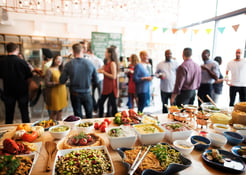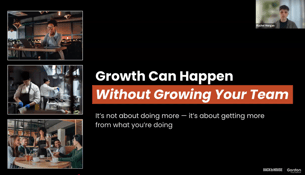Social media is an essential restaurant marketing tool. Platforms like Instagram and TikTok provide a direct channel for engaging your customers as well as an affordable way to promote your restaurant and attract new business. Restaurants that know how to leverage social media effectively have a competitive advantage.
Increasingly, influencers have become central to the social marketing strategies for restaurants. Working with influencers can be a simple and effective way to reach wider audiences, amplify your message, and convey your brand identity.
But how exactly can influencers fit into your broader restaurant marketing strategy?
To find out, we spoke with a few successful restaurant influencers.
1. Seek influencers who are compatible with your brand
The right influencer is more than just an Instagram user with a high follower count. You want to seek out influencers who are compatible with your broader restaurant marketing strategy. This means you need to connect with influencers who are actively engaged with the audiences and communities you wish to reach.
What should you look for in a compatible influencer?
“When I look at an influencer and just see a whole bunch of other influencers commenting in their comments, that’s a red flag,” said full-time influencer Christina Riley of NC Tripping. “If you’re based in Asheville, for example, you want to reach people in Asheville, not some random blogger in California.”
This is why it’s important to look beyond the follower count to identify influencers with authentic followers, active commenters and a community that overlaps with your target consumer. Or as Riley puts it plainly: “You want to reach real people.”
2. Be proactive
You can’t expect top influencers to come to you. It’s up to you to make first contact.
“I rarely reach out to restaurants unless the restaurant is really on brand for me – fine dining and Chinese and Southeast Asian food,” said Washington D.C.-based food influencer Albert Ting. “Restaurants generally reach out by Instagram DM or via email through their PR teams.”
Popular influencers get plenty of offers, so when you do reach out, be friendly, concise, and to-the-point. Invite the selected influencer to a hosted meal and request some basic information about their process.
3. Expect to pay for a popular restaurant influencer
When you host an influencer, you can expect to provide complimentary food and drink. But you may also be expected to pay a fee in exchange for the coverage and visibility that an influencer can provide.
“Influencing is not a hobby, it's a job,” said Ting, noting that his standard rate is $275 for a sponsored post. Some influencers may work solely in exchange for a free meal. But with influencers now playing a growing role in broader social marketing strategies for restaurants, this barter system approach is becoming less common.
Be sure to discuss fee structure, payment details, and contract arrangements upfront. If you are creating a contract, you’ll also want to discuss waitstaff tipping upfront. If an influencer isn’t open to tipping, alert waitstaff ahead of time.
4. Discuss posting expectations upfront
Make sure you know exactly what you’re getting when you enlist a restaurant influencer.
“All too often I hear about restaurants that ask an influencer to come by and afterwards the restaurant is disappointed that the influencer only posts a story,” said Ting. “Or that they don't post about the food at all, [but] just a selfie in the restaurant.That comes down to setting expectations.”
Make sure your expectations align with the influencer’s process. Find out how many posts are included, which platforms posts will appear on, and how soon after the meal they’ll be posted.
Most influencers don’t include negative criticism within posts, even if the experience had some hiccups. Riley noted that “I don’t genuinely think it’s fair to blast someone on social media, especially a small business.”
Still, it’s important to discuss the influencer’s posting policy in advance. Make sure everyone is on the same page.
5. Offer menu suggestions
Your restaurant should shine through your Influencer’s experience. Do everything you can to guide this experience. Feature the very best of what your kitchen has to offer.
“To get an idea of what to order, I usually ask three questions: ‘What’s the most popular dish?’, ‘What’s the prettiest dish’, and ‘What’s their favorite dish’,” Riley explained. “And then from there, I’ll stalk the restaurant’s Instagram feed to see what’s pretty.”
Help curate a dining experience for the influencer that highlights these elements. By spotlighting the best dishes and highlighting your menu’s best features, you help influencers capture the story you wish to tell.
6. Be strategic about seating
Influencers work in visual media so it’s not enough for your dishes to taste good. They also have to look good. Make sure you seat your influencer in a spot that casts your food and your restaurant in the best possible light.
Even the most experienced photographers will tell you that food is a challenging subject. This is especially true in dim settings. Top food influencers are generally exceptionally skilled at taking appetizing food photos.
But you still want to give the influencer the best opportunity to capture dishes with clarity and aesthetic appeal. Plan ahead by reserving a well-lit table in a space that shows your restaurant from its most flattering angle.
7. Share relevant background information in advance
When it comes to social media strategies for restaurants, having more information for an influencer is always better than less. Provide any information upfront that might help the influencer better tell the story of your brand. Share the restaurant’s history, accolades, and press clippings. Highlight a few signature design details, describe the vibe you’re going for, mention your favorite cocktail.
Make it easy for influencers to create posts that align with your restaurant marketing plan. As Ting explained, “I want to be helpful and informative to my followers, so I love it when a restaurant gives me a press release that I can use to supplement my own dining summary.”
Part of an effective marketing strategy is controlling the narrative. Offer up part of this narrative upfront so that you and your influencer are working to tell the same story.
8. Nurture long-term relationships
Relationships between influencers and restaurants are mutually beneficial.
“It’s an equal exchange,” explained Christina Riley. “Restaurants want the marketing, and we want the content.”
Once an influencer posts to social media, share it. Actively and positively engage with commenters. If you have a press section on your website, feature the posts. As Riley points out, “We love linkbacks.”
Just as importantly, when you foster a positive long-term relationship with an influencer, you are also building a relationship with that influencer’s community. This type of direct engagement can have tremendous ongoing value.
Why Influencers Should Be a Part of Your Restaurant Marketing Strategy
Influencers occupy a growing role in social marketing strategies for restaurants. But as the discussion above demonstrates, there’s a lot more to it than clicking and posting.
If you do plan to incorporate influencers into your restaurant marketing strategy, you’ll need to select influencers who align with your brand values, target audience, and expectations. You’ll also want to provide influencers with personalized menu suggestions, strategic seating arrangements, and relevant background information.
And most importantly, you’ll want to focus on cultivating long-term relationships. Effective influencer marketing is not just about one-time transactions but about nurturing collaborative partnerships that benefit both parties. The more work you put into these partnerships, the greater your reach will be into the communities where your partners carry influence.
Written with help from Grace Dickinson.





